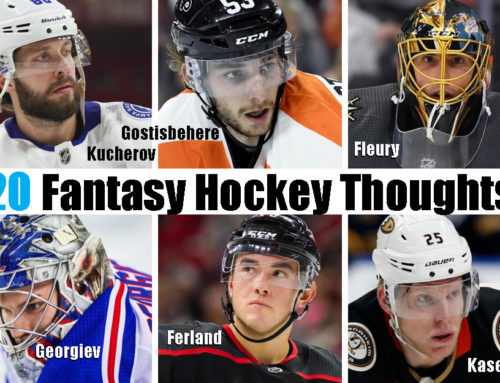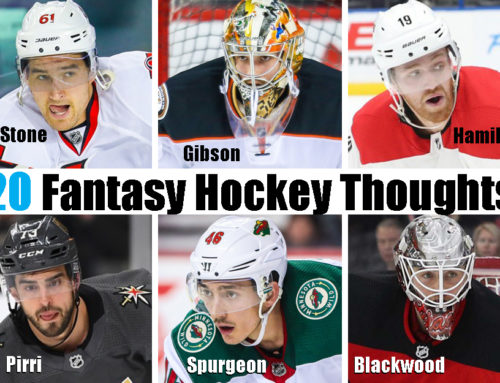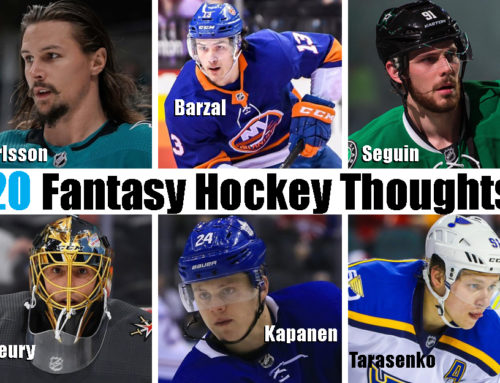 Every Sunday this off-season, we'll share 20 Fantasy Thoughts from our writers at Dobber Hockey. These thoughts are curated from the past week's "Daily Ramblings".
Every Sunday this off-season, we'll share 20 Fantasy Thoughts from our writers at Dobber Hockey. These thoughts are curated from the past week's "Daily Ramblings".
Contributors: Ian Gooding, Michael Clifford, and Neil Parker
1. I think new head coach John Stevens will make offense more of a priority in Los Angeles. In fact, that was noted with the hiring of Pierre Turgeon as the new offensive coordinator assistant coach. So, at least the plan is to open things up for the likes of Drew Doughty, Anze Kopitar and Tyler Toffoli.
For these three players, I’m thinking they will all have comeback seasons to a degree but it would be a stretch to say that they will have big seasons. Kopitar posted his first sub-60 point season of his career (not including lockout), while Toffoli recorded barely over half a point per game in an injury-shortened season. Yet both shot below their career averages in 2016-17 (Kopitar 6 percent below, Toffoli 2 percent below). Given their career numbers, I’d be willing to bet on an improvement for both in 2017-18.
2. Lots of young talent on the Coyotes. Can we call them the Paw Patrol instead of the Desert Dogs for the foreseeable future?
These are very preliminary projections and of course subject to change:
Clayton Keller: 20 goals, 25 assists, 45 points
Brendan Perlini: 15 goals, 15 assists, 30 points
Dylan Strome: 10 goals, 30 assists, 40 points
Max Domi: 20 goals, 35 assists, 55 points
Jakob Chychrun: 10 goals, 20 assists, 30 points
3. Derek Stepan will prove to be a solid addition to help insulate the young Coyotes from daunting matchups and it will also likely allow Christian Dvorak to slide to the wing. Similarly, Nick Cousins could prove to be an underrated grab, as he has had excellent offensive success at the lower levels but was never given a fair shake with Philadelphia.
4. It’s easy to see how close John Tavares is to returning to form in the fantasy game. A better power-play setup could add five points, while better fortune at five-on-five would add five more. The former requires a leap of faith that the new coaching regime headed by Doug Weight will find a better way to utilize Tavares.
For almost any player to be an elite fantasy option, he needs to amass at least 25 power-play points, rather than the sub-20 PPP seasons Tavares has put up the last two years. Fixing the power play, and namely how he is used in said power play, will go a long way in bringing Tavares to the fantasy promised land. Whether it happens or not is another question but at least you won’t have to pay a first-round price in fantasy drafts to find out.
5. Last year was a full-fledged breakout for Anders Lee. His 34 goals tied him for 10th in the league with David Pastrnak and Patrick Kane, while his 24 five-on-five goals was more than Max Pacioretty or Vladimir Tarasenko.
Of course, those 24 five-on-five goals were the result of a percentage binge, as he shot 16.33 percent, by far a career-high. I look at that as a natural rebound from 2015-16 when he shot just 4.38 percent. Given his history, he’s probably a 10-11 percent shooter. Which is great.
I do think we see a big decline in goals this year, though. His shot rate has been declining for a few years now (per minute, not per game), and a decline in shot rate combined with an inevitable decline in shooting percentage probably sees him finish between 20-25 goals rather than 30-plus.
At the least, he probably won’t be overvalued in fantasy drafts and I think he’s stuck to Tavares’ hip even with Jordan Eberle coming to town. He can still be a useful player but surpassing 50 points seems to be the high-water mark for him.
6. The goaltending situation alone could plummet Vancouver into last place. Jacob Markstrom hasn't shown enough consistency to qualify as a No. 1 goalie, while Anders Nilsson fits the same bill, albet it with less pedigree. However, it is worth noting that Nilsson is coming off a nice season (.923 save percentage through 26 games) with Buffalo.
7. The Sharks will need Timo Meier, Mikkel Boedker, Tomas Hertl, and Jannik Hansen to all take a step forward, and with Patrick Marleau gone, a couple of them probably will. Additionally, Kevin Labanc and Daniel O'Regan are promising young forwards, while Tim Heed has a chance to crack the roster on the blue line.
8. Calgary improved significantly this summer and the Flames still have some interesting pieces in their system in Mark Jankowski, Andrew Mangiapane, Rasmus Andersson, Oliver Kylington, and Tyler Parsons.
9. After settling in as a 50-60 point player with a heavy concentration of goals, Brad Marchand saw his career take off following his experience with Sidney Crosby at the World Cup of Hockey. One factor was more critical to that success than anything else: power-play time.
In 2016-17, Marchand recorded 24 power-play points, easily a career high considering that he never had more than eight power-play points in a season. Power-play time drove that, as he averaged 2:41 of power-play time on the first power-play unit in 2016-17, but just 1:28 in 2015-16 and just 0:59 (15th on the Bruins!) in 2014-15. Needless to say, he should remain on the Bruins’ first power-play unit after inexplicably having to wait for several years.
Marchand jumped from 61 points in 2015-16, to 85 points in 2016-17, so not all of that increase is accounted for by power-play points. His goal total increased by two last season, but he managed to do so by taking 24 fewer shots. His shooting percentage increased from 14.8% in 2015-16, to 17.3% in 2016-17, but it’s also worth mentioning that Marchand averaged 17% earlier in his career.
I own Marchand in one of my keeper leagues right now and I fully intend to keep him. If you can obtain elite-level talent for him, then it doesn’t hurt to offer him in a trade. Reaching 85 points again probably won’t happen but something in the 70-80 point range for Marchand seems reasonable to me.
10. Up front, Boston needs a winger — and maybe two — to slot into a top-six role. Frank Vatrano and Ryan Spooner are in-house options that haven't completely made that jump. In the lower ranks, Anders Bjork, Zach Senyshyn, Jake DeBrusk, Peter Cehlarik, Danton Heinen and Jakob Forsbacka-Karlsson are all positioning themselves to be future Bruins. However, none of the youngsters stand out as an immediate fix. There are juicy fantasy spots available for the taking, so Boston's depth chart is worth keeping tabs on leading into the season and throughout.
11. An offensive decline hit Corey Perry in 2016-17 and the 32-year-old winger might not fully bounce back. Could Ryan Getzlaf and/or Ryan Kesler be next to begin slowing down? That's the real concern with the Ducks. There are solid supporting pieces in place, and specifically, Rickard Rakell and Jakob Silfverberg are high-end players. However, Getzlaf, Perry and Kesler still are the driving forces.
Ondrej Kase and Nick Ritchie both flashed upside last year, and Sam Steel, Troy Terry and Kalle Kossila are interesting potential additions to the roster, but this team is going to lean on its three veterans.
For our fantasy purposes, it's likely that Anaheim attempts to run three lines with Getzlaf, Perry and Kesler all separated. Patrick Eaves worked well with Getzlaf last year and Rakell spent a lot of time centering Perry. It would be better if Anaheim tried to load up a top line, though, so it's something to watch.
12. A lot of Damon Severson’s fantasy value will be tied to his usage. The same could be said for a lot of players but unless Nico Hischier emerges as a true offensive force in his rookie year, the Devils could still largely be a one-line offensive team.
Heavy usage on the top power-play unit, though, will go a long way to mitigate the issues Severson could have with five-on-five point totals. With more ice time, he has 40-point potential in 2017-18, and you absolutely will not have to pay for it at the draft table. Just be wary of roto leagues, particularly those with blocked shots/hits as categories, as his value will be lower in such formats.
13. Tampa Bay locked down Tyler Johnson to a seven-year deal with a $5 million AAV. Johnson turns 27 near the end of July and he had 19 goals and 45 points in 66 games last year. There should be a bit of concern here. One season has carried his reputation and it hasn’t been pretty since. In fact, in the two seasons since that 72-point campaign, he has the same points-per-60-minutes rate as Jussi Jokinen and P.A. Parenteau. One guy was bought out, the other has been bought out before and can’t find a new team. Injuries have played a factor, sure, but that’s a long term.
Fantasy-wise, it’s time for owners to adjust their expectations. In a full season, with his usage, Johnson can be a 20-goal, 50-point guy. Expecting him to return anywhere near where he was in 2014-15, however, seems misguided. This is another player I’d be looking to deal in cap leagues.
14. On the surface, Jaccob Slavin is probably going to be a better real-world player than fantasy. That isn’t meant as a slight; he’s a very good young defenceman and profiles as a solid top-pair guy for years to come.
He is a guy, however, who hasn’t shot much over his first two years in the league, putting up a similar rate to other blueliners like Zach Bogosian and Nick Leddy. Of course, Leddy has fantasy relevance, so it’s very possible Slavin will eventually, as well. The difference is that Leddy has often been used as the primary defenceman on the top power-play unit, while Carolina used one of Justin Faulk or Noah Hanifin as primary power play options last year. This led to Slavin managing less than a minute per game of power-play time. Without more than a handful of power-play points, and with his limited shot rate, it’ll be hard to have much fantasy relevance.
Those in cap leagues that aren’t in full rebuilding mode should be looking to trade Slavin. Faulk should be around for at least three more years, and although Hanifin’s name has been floated as trade bait, it’s hard to rely on rumour to build a fantasy roster. His role on the team likely means Slavin’s 2016-17 season is about what we can expect for production in 2017-18.
15. Last season, Jaromir Jagr had more even-strength points (33) than Patrice Bergeron, Anze Kopitar, Joe Thornton, Jason Spezza, Matt Duchene, Ryan O'Reilly, Nick Foligno, Daniel Sedin, Wayne Simmonds, Jonathan Drouin, among others. Not bad for a 45-year-old. (Props to our own Fred Poulin for providing that fun fact.)
16. The Maple Leafs have themselves in a bit of a cap pickle and it's up for debate how successful their off-season was. Throwing hefty salaries at Patrick Marleau and Ron Hainsey was bold, and it was also potentially stupid. At least, the two veterans are still exceptional skaters.
Nazem Kadri's deal now looks like a steal. Frederik Andersen, Morgan Rielly, Nikita Zaitsev and Jake Gardiner are also all on the books at reasonable tickets, so it's not all doom and gloom. However, paydays await for Auston Matthews, Mitch Marner and William Nylander.
Toronto is still a better team entering 2017-18 than it was a year ago and there is star power throughout the lineup. Rielly and Gardiner both have the potential to take another step forward and, offensively, the Maple Leafs exceeded expectations last season with a fifth-ranked 3.05 goals per game and ninth-ranked 11.9 high-danger scoring chances per 60 minutes.
There might be more chips pushed in earlier than fans may have wanted but it's a boon for our fantasy interests. Those salary concerns might disappear quickly, too.
17. Brendan Gallagher took a sizeable step backward last year, while Alex Galchenyuk has probably had his development hindered by his usage over the past few seasons. Considering those are two of the best forwards on the Canadiens roster, it's a alarming that there are clear question marks. Max Pacioretty is a high-end scorer and Jonathan Drouin certainly has the potential to be an elite point producer, but that's it.
Paul Byron had a nice offensive showing in 2016-17, while both Artturi Lehkonen and Phillip Danault have nice upside as secondary scorers. Ales Hemsky could have a throwback season in store, too. Maybe Nikita Scherbak or Charles Hudon make a splash? But when it's all said and done, this might be the worst forward group in the division.
18. The issue with Detroit is that Tomas Tatar and Gustav Nyquist haven't ascended to being go-to scorers, and despite still posting solid numbers, Henrik Zetterberg isn’t capable of carrying a team on his shoulders. Anthony Mantha and Dylan Larkin are encouraging as the next wave of talent but is either going to become a team-leading star?
19. The Sabres should generate more offense. Jack Eichel and Ryan O'Reilly form an admirable one-two punch up the middle and there is the forward depth to roll out three scoring lines. Kyle Okposo, Evander Kane, Jason Pominville, Sam Reinhart, Alexander Nylander, Matt Moulson and Benoit Pouliot can all mix and match to give Buffalo plenty of options. Additionally, Johan Larsson, Zemgus Girgensons, Nicholas Baptiste and Hudson Fasching are all capable of moving the offensive needle to varying degrees. There are a lot of moving pieces here, as well as a lot of talent. The team’s first-round selection in 2017, Casey Mittelstadt, only adds to the abundance of riches.
20. Ryan Johansen has undergone a change in personal style of sorts since coming over from Columbus. In his two big offensive season with the Jackets, he averaged over 2.6 shots per game, while that number has dipped to nearly an even 2.0 since donning a Predators uniform. His mark of 1.88 shots per game in 2016-17 was the lowest since his rookie season.
One can hardly blame him, though, given his three most-common wingers were Filip Forsberg, Viktor Arvidsson and James Neal, all shooters. He doesn’t need to take the shots, he needs to put himself in a situation where he can find his wingers in shooting positions. That’s his job.
Being the distributor does have its upsides, of course – the soon-to-be 25-year-old centre managed a career high with 47 assists and tied a career-best with 19 power-play assists. All these assists helped him become one of just 12 forwards with four consecutive 60-point seasons since the lockout year.
Settling into his role has allowed Johansen to fulfill a need for the Predators but it also creates problems for fantasy owners. The long and short of it is his fantasy value varies wildly across different league setups. In a points-only league, he could be very useful depending how goals and assists are valued. In standard roto leagues, however, the lack of peripherals meant that despite 61 points – 23 of which came with the man advantage – he still wasn’t a top-50 option. Even if he adds a handful of goals, he’s barely a top-50 player in such leagues and that is where he will probably be overvalued.
Being a fringe top-50 roto option is still very, very good. I don’t want to give the impression that he’s useless or something. However, the lack of shots and goals means that being roughly a top-50 player is about his ceiling. Whereas you can draft Forsberg inside the top-50 and legitimately hope for a top-10 season. If you draft Johansen inside the top-50, you’re hoping he simply returns that value.
Have a good week, folks!!
One Comment
Leave A Comment
You must be logged in to post a comment.





 MTL
MTL VGK
VGK OTT
OTT CGY
CGY DET
DET ANA
ANA NSH
NSH TOR
TOR

great article